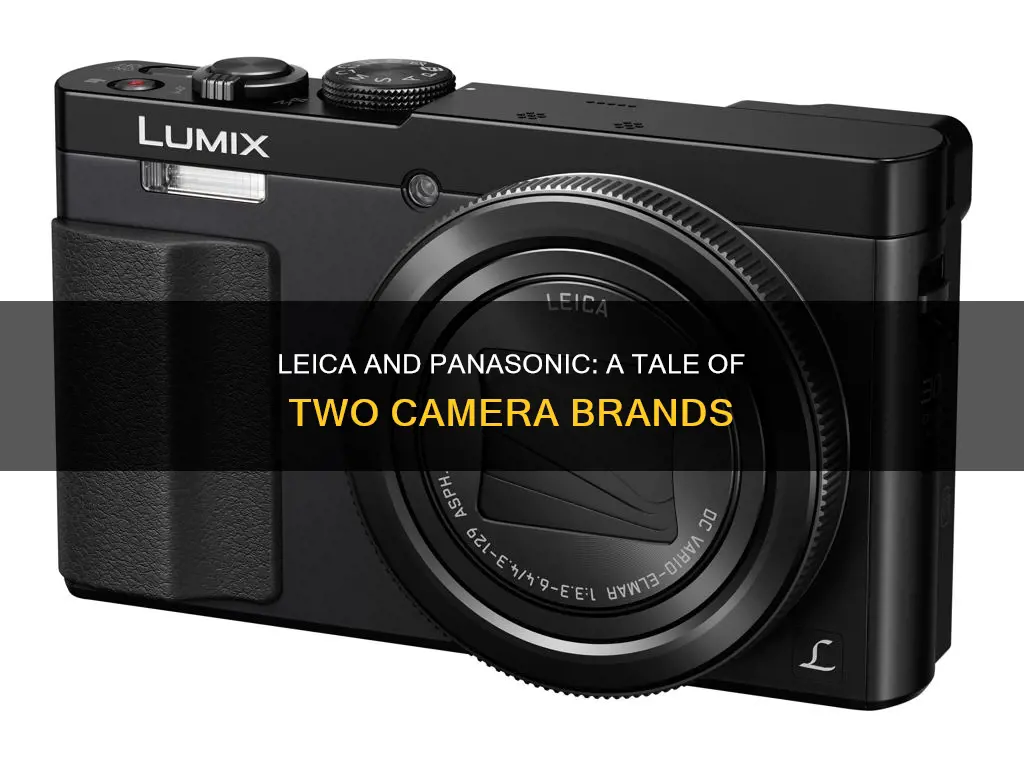
Leica and Panasonic have had a long-standing partnership since 2000, when they initially signed a cooperation agreement for lenses for digital audio-visual equipment. In 2001, the companies decided to extend their partnership to the digital camera sector as well. Over the years, Leica and Panasonic have expanded their technological cooperation, with Panasonic using Leica lenses on its premium Lumix cameras and Leica rebranding Panasonic cameras. In 2022, the two companies announced a new initiative called L2, which involves developing new cameras, lenses, and imaging technology together.
| Characteristics | Values |
|---|---|
| Leica and Panasonic's relationship | Leica rebrands Panasonic cameras and Panasonic uses Leica's name on some of their best lenses. |
| First collaboration | The companies first signed a cooperation agreement for lenses of digital and audio-visual equipment in August 2000. |
| Digital camera cooperation | In 2001, Leica and Panasonic decided to cooperate in the digital camera sector. |
| L-Mount Alliance | In 2018, Leica, Panasonic, and Sigma founded the L-Mount Alliance, allowing them to use the L-mount standard developed by Leica. |
| L2 Technology | In 2022, Leica and Panasonic announced L2 Technology, a collaboration to develop new cameras, lenses, and imaging technology. |
| Panasonic's focus | Panasonic is shifting its focus to developing high-end mirrorless cameras for photography enthusiasts and professionals. |
What You'll Learn

Leica and Panasonic's L2 Technology
Leica Camera AG and Panasonic have enjoyed a long history of collaboration, with the two companies first signing a cooperation agreement in 2000 for lenses in digital and audio-visual equipment. This was expanded in 2001 to include the digital camera sector. In 2018, the two companies, along with Sigma, founded the L-Mount Alliance, which allowed Panasonic and Sigma to use the L-mount standard developed by Leica.
In 2022, Leica and Panasonic announced a new initiative called L2 Technology, which would see the two companies work even closer together in developing digital cameras, lenses, and software. L2 Technology will combine the strengths of both brands by bringing together their respective technologies and know-how in the fields of camera and lens products, as well as next-generation software.
Through this collaboration, Leica and Panasonic aim to maximise the synergies of their respective optical, imaging, video, and digital technologies, which they have cultivated over many years in the camera and imaging market. They will jointly invest in new technologies that can be incorporated into camera and lens products, with the L2 Technology featuring in their respective marketing activities to develop a collaborative system for the long term.
L2 Technology is not a new alliance but a symbol of Leica and Panasonic's commitment to investing in and developing new value together. Panasonic has stated that L2 Technology is completely distinct from the L-Mount partnership and that they are aiming to maintain stable product compatibility between the L-Mount alliance members.
The collaboration between Leica and Panasonic is an interesting one, with some commentators speculating that it could lead to the introduction of technologies from other segments of the market, such as smartphones, into future cameras. Only time will tell what new imaging worlds this partnership will create.
The Everlasting WiFi Camera: Maximizing Battery Life
You may want to see also

Panasonic Lumix cameras
Panasonic has been using Leica lenses on its premium LUMIX cameras for some time. In fact, Leica and Panasonic have been working together since 2000, initially signing a cooperation agreement for lenses of digital and audio-visual equipment. In 2001, they decided to also cooperate in the digital camera sector.
The LUMIX range offers superior image quality, with compositions that faithfully reflect the photographer's intent. The G Series, popular with semi-professionals and professionals, provides low-light and 6K/4K video capabilities for the wide-aspect Hollywood look.
The LUMIX GH7 is a mirrorless micro four-thirds camera with enhanced video speed and quality, optimised workflows, and Adobe Cloud compatibility. The LUMIX G7 4K Digital Camera comes with a 16-megapixel mirrorless camera and a 3-inch LCD screen. The LUMIX S5IIX is a mirrorless camera with 24.2MP, a full-frame, and phase hybrid AF. The LUMIX FZ300 is a long-zoom digital camera with a 12.1-megapixel sensor and a 24X F2.8 zoom lens. The LUMIX S5 is a full-frame mirrorless camera with 4K 60P video recording, a flip screen, and WiFi. The LUMIX G95D is a 20.3-megapixel mirrorless camera with a 3” OLED touchscreen. The LUMIX ZS100 is a 4K digital camera with a 1-inch sensor, a 20.1-megapixel camera, and a 10X Leica DC Vario-Elmarit lens.
Beach Camera Sales Tax: What You Need to Know
You may want to see also

Leica lenses on Panasonic Lumix cameras
Leica and Panasonic have been working together since 2000, initially signing a cooperation agreement for lenses in digital and audiovisual equipment. In 2001, they expanded this to include digital cameras. Since then, the two companies have continued to deepen their technological cooperation.
In 2018, Leica, Panasonic, and Sigma founded the L-Mount Alliance, a cooperation that enabled the companies to use the L-mount standard developed by Leica for their own developments. This meant that Panasonic and Sigma could offer cameras and optics with this lens mount.
In 2022, Leica and Panasonic announced a new initiative called L2 Technology, which would see them work even more closely together to develop digital cameras, lenses, and software. As part of this collaboration, Panasonic has been using Leica lenses on its premium LUMIX cameras, and the two companies have also been sharing technologies in developing their products.
Some of the Leica lenses that can be used on Panasonic LUMIX cameras include:
- Leica DG Summilux 9mm f/1.7 ASPH. Lens
- Leica DG Vario-Summilux 10-25mm f/1.7 ASPH. Lens
- Leica DG Vario-Elmar 100-400mm f/4-6.3 ASPH. POWER O.I.S. Lens
- Leica DG Vario-Elmarit 12-60mm f/2.8-4 ASPH. POWER O.I.S. Lens
- Leica DG Vario-Elmarit 12-35mm f/2.8 ASPH. POWER O.I.S. Lens
- Leica DG Summilux 12mm f/1.4 ASPH. Lens
- Leica DG Vario-Elmarit 8-18mm f/2.8-4 ASPH. Lens
- Leica DG Vario-Elmarit 50-200mm f/2.8-4 ASPH. POWER O.I.S. Lens
- Leica DG Summilux 25mm f/1.4 II ASPH. Lens
- Leica DG Vario-Elmar 100-400mm f/4-6.3 ASPH. POWER O.I.S. Lens
- Leica DG Vario-Elmarit 8-18mm f/2.8-4 ASPH. Lens
- Leica DG Summilux 15mm f/1.7 ASPH. Lens
- Leica DG Vario-Elmarit 50-200mm f/2.8-4 ASPH. POWER O.I.S. Lens
- Leica DG Summilux 25mm f/1.4 II ASPH. Lens
- Leica DG Macro-Elmarit 45mm f/2.8 ASPH. MEGA O.I.S. Lens
- Leica DG Nocticron 42.5mm f/1.2 ASPH. POWER O.I.S. Lens
Charging Your Spy Watch Camera: A Step-by-Step Guide
You may want to see also

The L-Mount Alliance
Leica, the creator of the L-Mount, has been using it for its entire run of mirrorless, non-rangefinder cameras. The mount was initially introduced as the T-mount in 2014, coinciding with the release of the original T mirrorless camera. Leica then switched to the L-mount name with the release of the SL camera in 2015. Since then, Leica has split camera development into both full-frame and APS-C divisions. The SL2 is its current L-mount flagship, featuring a 47.3MP full-frame sensor, impressive EVF and connectivity specs, and apt video capabilities.
Panasonic, on the other hand, is the least "niche" of the three brands, with a more diversified camera lineup that appeals to a wider range of users, from video specialists to high-resolution photographers and travel-oriented shooters. Coinciding with the L-Mount Alliance's debut, Panasonic announced its L-mount camera bodies: the S1 series, including the Lumix DC-S1 and DC-S1R. The S1 is an all-around model with a 24MP full-frame sensor, UHD 4K video capabilities, and robust specifications. The S1R, on the other hand, targets landscape and portrait photographers with its 47.3MP full-frame sensor. Panasonic later introduced the Lumix DC-S5, a more compact and travel-friendly model with excellent video capabilities and a 24.2MP full-frame sensor.
Sigma, the third member of the alliance, is known for its history of camera and lens production. With the L-mount, Sigma gains the opportunity to make a splash as a native lens maker on a larger scale. Sigma's first camera under the alliance, the fp, is unique in that it uses a Bayer array sensor instead of their typical Foveon design, and it is designed primarily for the video crowd. Sigma has also been the most prolific of the three brands in lens production, with a wide range of lenses available for the L-mount.
Unlocking Portrait Mode on Your LG Stylo 4 Camera
You may want to see also

Panasonic's focus on high-end mirrorless cameras
Panasonic has a range of mirrorless cameras under its LUMIX brand, from point-and-shoots to DSLRs, catering to different budgets and experience levels. The company is known for its pioneering work on the Micro Four Thirds (MFT) camera and lens system, in collaboration with Olympus.
In 2018, Panasonic entered into the L-Mount Alliance with Sigma and Leica, allowing them to produce full-frame cameras. Panasonic's full-frame mirrorless camera offerings include the S5II, S5IIX, and S5II body, with regular prices ranging from $1,999.99 to $2,749.99. These cameras offer excellent video capabilities, with features like open gate 6K recording, vectorscope functionality, and built-in heat vents to reduce overheating. They also have impressive in-body image stabilization (IBIS) systems and ergonomic designs.
The LUMIX G9 II is another mirrorless camera, retailing for $1,699.99, that offers excellent video capabilities and is particularly well-suited for sports and wildlife photography due to its 2x crop factor. The G9 II also has impressive IBIS and advanced autofocus capabilities.
Panasonic's GH series, including the GH6, is also popular among videographers and YouTubers. The GH6 has a 25-megapixel Micro Four Thirds sensor and is designed with videography in mind, featuring built-in heat vents, a fully articulated display, and two video record buttons. The GH6 offers a wide array of recording formats and codec options, including internal ProRes codecs, and 4k shooting at up to 120 fps without a crop.
While Panasonic has a strong focus on video capabilities, they also offer impressive stills cameras, with versatile body and sensor sizes catering to different needs, from compact travel companions to high-performing video devices.
Where's the Adjustment Brush? Camera Raw's Essential Tool
You may want to see also
Frequently asked questions
Leica and Panasonic have been working together since 2000, initially signing a cooperation agreement for lenses of digital and audio-visual equipment. In 2001, they expanded their partnership to include the digital camera sector. In 2018, they founded the "L-Mount Alliance" with Sigma, allowing all three companies to use the L-mount standard Leica developed for their optics and camera bodies. In 2022, they announced a new initiative called L2, which involves sharing technologies to develop new cameras, lenses, and imaging technology.
The L2 initiative is a collaboration between Leica and Panasonic to share technologies and develop new products in the camera, lens, and software space. The L2 name is derived from the first letter of each company's name.
The L-Mount Alliance is a collaboration between Leica, Panasonic, Sigma, and Ernst Leitz Wetzlar GmbH. It enables the companies to use the L-mount standard developed by Leica for their optics and camera bodies.







